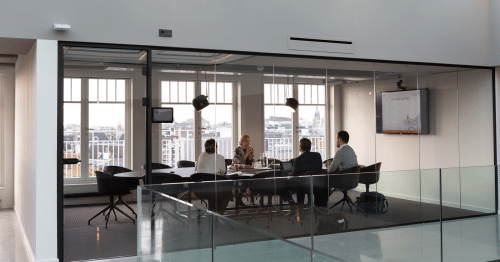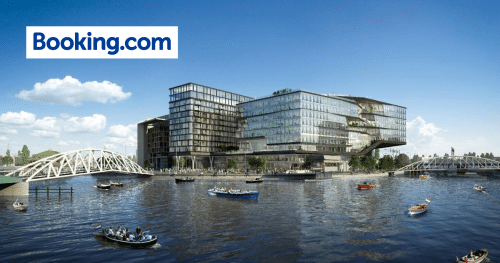A retrofit program offers the opportunity for property owners & developers to extend beyond the realms of sustainability and energy efficiency. Adopting a holistic retrofit vision that incorporates measures to improve employee well-being and enhanced user experience into retrofits can create unique value and differentiation opportunities.
In this article we’ll delve deep into:
- Retrofitting for Enhanced Workplace Experience and additional retrofits to consider
- Leveraging Technology in Sustainable Retrofit
- 10 Key Factors for Retrofit Success
Retrofitting for Enhanced Workplace Experience
Retrofitting projects offer a chance to improve employee well-being and workplace satisfaction. With evolving expectations, there’s a growing demand for comfortable, collaborative, and personalized spaces. Property owners can enhance their properties by integrating sustainable design and technology, aligning with market trends and tenant preferences.

These additional retrofit considerations may include:
Technological Integration for User Experience
Integrating smart systems via retrofitting brings personal comfort and workspace customization. Motion-activated lighting and app-controlled temperatures offer employees control over their environment. Interactive panels aid collaboration and content sharing digitally, enhancing effectiveness. Data analytics from IoT systems inform future retrofits and workplace strategies, meeting evolving occupancy needs proactively.
Health & Productivity Improvements
Environmental factors like lighting and ventilation significantly impact users’ mental health and productivity. Retrofits offer opportunities to enhance natural light, improve ventilation, use less-toxic materials, and create positive psychophysiological benefits.
Studies show correlations between indoor air quality and cognitive function. For instance, well-ventilated “green” offices lead to higher cognitive function scores. Natural light also boosts employee experience, reducing eyestrain and headaches and improving concentration.
Circadian lighting solutions mimic natural light, further enhancing focus and mood. Improving indoor air quality through retrofitting, with interventions like advanced ventilation and HEPA filtration, can reduce absenteeism and respiratory illness-related costs.
With mental health issues costing the global economy $2.5 trillion per year, retrofits should seize the opportunity to create environments for building users, delivering spaces that uplift psychological and physiological health.
Design and Aesthetics
Sustainable design principles allow retrofitting projects to holistically improve workspace aesthetics in tandem with functional upgrades. For example, offices retrofitted with light wells, skylights, and window light shelves improve natural lighting visually and environmentally. Designed collaborative layouts feel more open. Ergonomic furnishings and varied work/lounge seating arrangements create spatial dynamics.
These design enhancements can influence tenant perception and differentiate properties beyond purely operational targets. However, style should still uphold sustainable ideals – using reclaimed materials, renewable textures, and local art can imbue spaces with eco-conscious appeal. By balancing beauty and responsibility, retrofit design refinements can transform workspaces to attract clients and talent.
Community and Social Spaces
As the very nature of work evolves to embrace flexibility and collaboration, dedicating spaces to communal use and social activity is an emerging consideration in workplace design.
Open office concepts aim to foster collaboration but lack privacy, whereas alternate shared spaces designs foster a feeling of community without compromising focused work. Retrofits provide opportunities to create new spaces such as lounges, relaxation zones, roof gardens, or casual meeting areas to bring people together and introduce unique tenant amenities. Data shows elements like this can increase perceived value of spaces, job satisfaction and employee productivity. So carving out social spots via retrofitting caters to shared moments that ultimately support better engagement, interaction, and amenities that together benefit recruitment, retention and the bottom line.
8 Ways to Leverage Technology in Sustainable Retrofit
Emerging technologies including the Internet of Things (IoT), artificial intelligence (AI), and cloud computing can play a significant role in not only streamlining the retrofit process but also in enhancing the functionality and sustainability of buildings post-retrofit. By fully leveraging these technologies, property owners can accelerate the pace of retrofits, maximize economic returns, and ensure their buildings are not just compliant with current standards but are also future-proofed in an ever-evolving technology landscape.
Let’s explore 8 ways you can enhance your buildings post-retrofitting:
- Enhanced Efficiency: IoT and AI technologies are transforming retrofit processes by providing real-time monitoring and adjustment capabilities. This optimizes critical systems like HVAC and lighting, significantly improving operational efficiency.
- Smart Building Capabilities: IoT sensors and controllers offer granular monitoring, managing energy use, and improving operational efficiency. The US Department of Energy (DoE) notes that optimizing HVAC operation using occupancy-centric controls can reduce a building’s energy use by 20-40%, with lighting systems offering similar savings.
- Predictive Maintenance: AI algorithms used for Fault Detection and Diagnostics can be used to reduce operational costs, optimize maintenance and ensuring optimal systems performance post-retrofit. For example, an HVAC system that is not properly maintained and in need of serious repair will consume much more energy than a more efficient one.
- Data Integration via Cloud: Cloud computing provides scalable and flexible tools for gathering and processing vast volumes of data from different building systems, delivering actionable insights. Access to accurate, real-time data is invaluable for stakeholders in making informed decisions during retrofit planning.
- Scenario Modelling: Predictive analytics tools model various retrofit scenarios, validating returns and identifying optimal solutions.
- Strategic Planning: Access to historical data and market insights helps in making informed strategic decisions.
- Cost-Benefit Analysis: Evaluating financial and sustainability returns of different retrofit options ensures that investments are prioritized effectively.
- Performance Tracking: Ongoing IoT-enabled performance tracking post-retrofit confirms efficacy and allows for continuous enhancements, ensuring buildings meet efficiency standards and adapt to market evolution. Evaluating a building’s performance post-retrofit meets expectations using accurate data and metrics is also critical. This is achieved through:
- Smart Sensors: Installation of smart sensors plays a pivotal role in accurately measuring parameters including energy usage and indoor air quality.
- Real-Time Insights: These sensors provide real-time data for immediate adjustments, ensuring the retrofit’s effectiveness.
- Benchmarking and Reporting: Continuous data monitoring aids in benchmarking performance against industry standards and reporting metrics for improvement.
By embracing technological advancements, the real estate industry can significantly contribute to emissions reduction. Tech-enabled solutions not only provide faster payback periods to incentivize owners but also propel the industry towards a sustainable, zero-carbon future. Proactive use of IoT, AI, and cloud technologies is therefore not just an option but a necessity for the industry’s evolution and alignment with global environmental targets.
8 Key Factors for Retrofit Success
The following key considerations can guide stakeholders through the complex process of retrofitting, ensuring that every aspect – from stakeholder engagement to energy efficiency – is meticulously planned and executed. By adhering to these guidelines, property owners and developers can minimize risks, ensure buy-in, evaluate and deliver on returns and competitive advantage and set a benchmark for future developments.
Below is a list of 8 key considerations for the effective delivery of sustainable retrofit projects:
- Stakeholder Engagement and Collaboration: Engaging in early collaboration with a broad spectrum of stakeholders is vital for developing a robust business case for sustainable retrofit projects. This group includes internal stakeholders such as property management teams, facility managers, and corporate leadership, as well as external parties like tenants, investors, local community representatives, environmental consultants, and regulatory bodies. Utilizing data-driven insights is key to facilitating informed decision-making and securing buy-in from all these stakeholders. Their diverse perspectives and expertise can provide valuable input, ensuring that the retrofit project aligns with varied interests and complies with sustainability goals.
- Comprehensive Impact Analysis: A mix of market insights and IoT data should be used to evaluate the impact of retrofitting on factors like rental value and operational costs, establishing clear metrics for risk and return assessment.
- Project Definition and Cost Estimation: Detailed cost estimations should be compiled, utilizing IoT data on building performance for accurate forecasting, alongside an assessment of market trends to determine post-retrofit rents and occupancy rates.
- Identifying Retrofit Opportunities: Retrofit suitability should be evaluated based on tenant activities and market demands, with market analysis guiding capital investment decisions.
- Physical Renovations and Modernization: Renovations should respond to competitive analysis and tenant preferences, focusing on modernizing spaces and enhancing amenities to boost the property’s appeal.
- Placemaking and User Experience: Creating spaces that enhance user experience and placemaking is key, with sensor data providing insights for optimizing space utilization and enhancing tenant satisfaction.
- Energy and Climate Impact Assessment: Assessing the building’s environmental impact is crucial, with retrofit solutions aimed at maximizing energy efficiency and reducing emissions.
- Planning and Execution of Retrofit: Retrofitting should be thoroughly planned in advance, with a focus on reducing energy demands and implementing measures coherently to ensure optimal performance.
Download our full guide to unlock 3 extra key considerations that will be beneficial for your buildings.
The Clear Call to Action for CRE Stakeholders
The imperative to develop sustainable, amenity-rich buildings is growing, driven not only by tenant preferences but also by the increasing influence of climate change on asset valuations, rental incomes, and occupancy rates. The CRE sector stands at a critical juncture where adaptation to sustainability is no longer optional but a strategic necessity for long-term value preservation and market competitiveness.
Retrofitting is more than just a compliance measure; it’s an investment in the future viability of CRE assets. It elevates a property’s marketability today and secures its relevance for tomorrow’s market landscape. In an era marked by stringent regulatory sustainability enforcement, retrofitting positions CRE assets to thrive amidst market shifts and regulatory evolutions.
CRE stakeholders, including owners and investors, must strategically decide between new construction, retrofitting existing buildings, or reshaping their portfolios. Sustainable retrofits, fueled by innovation and strategic foresight, offer a compelling path to attracting new tenants, enhancing rental returns, and optimizing space utilization based on data-driven insights.
A proactive, creative, and strategic retrofitting approach is essential for recovering value and generating returns in a challenging market. Individual asset assessments, within the context of broader portfolios, will be crucial. For owners of older, lower-quality assets, inaction is a pathway to obsolescence. Landlords investing in sustainability, amenities, and community engagement can ride the wave of the flight to quality, reaping the benefits of a more resilient and desirable portfolio.
Failing to leverage technology in this transformation could be a missed opportunity. CRE firms willing to innovate and explore technological solutions can unlock long-term potential, balancing investment decisions against current market challenges. By navigating these turbulent times with an eye on sustainability and technological integration, CRE stakeholders can emerge more robust, resilient, and competitively positioned.
The call to action is clear and inaction represents a huge risk given the rapidly evolving CRE landscape. Stakeholders must engage with the sustainability transformation, not as a compliance exercise but as a strategic business decision. The path forward involves embracing change, innovating solutions, and recognizing that sustainability and technology are not just trends but fundamental drivers of future success in the CRE sector.










